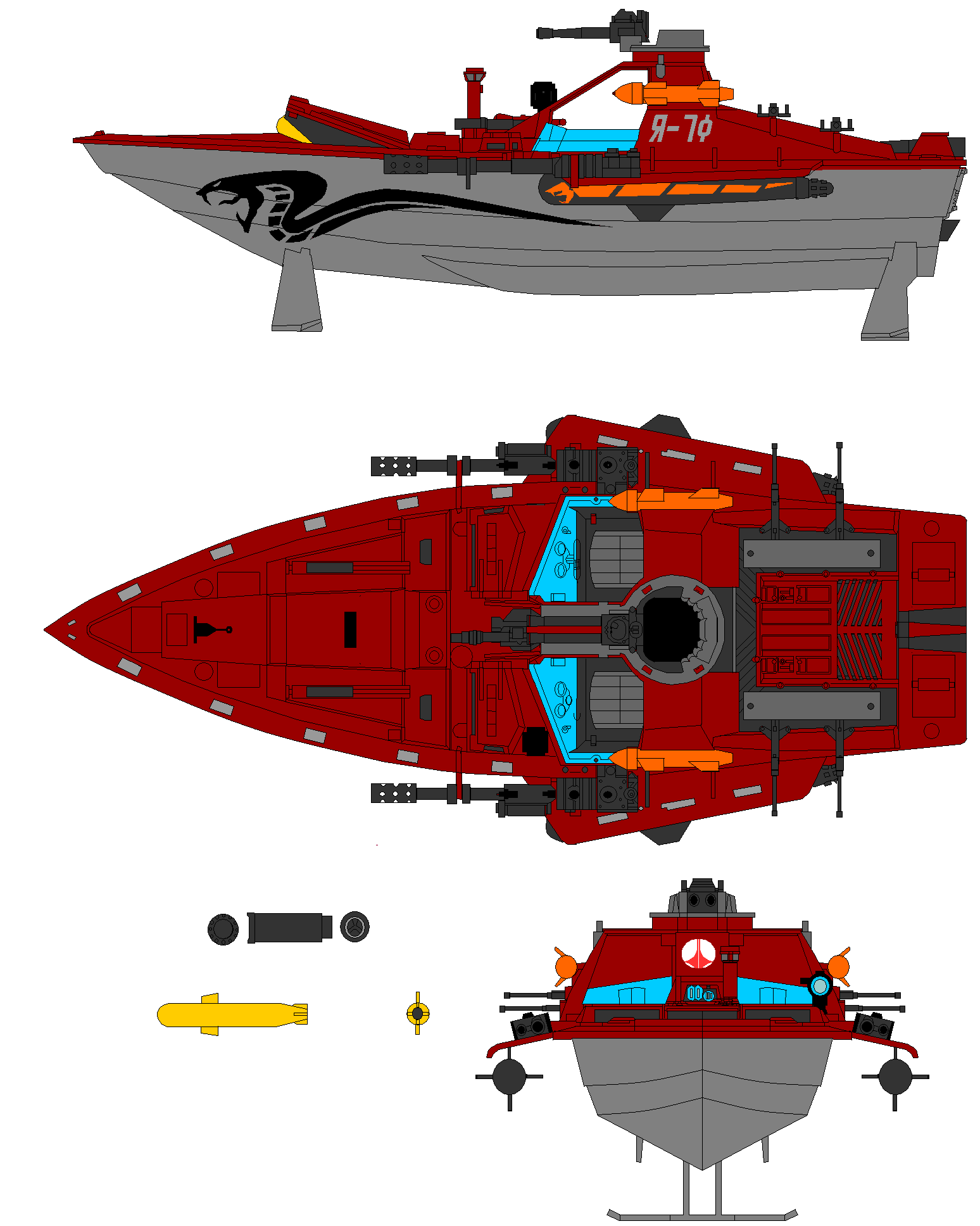
Terran United Nations. | MORAY-Class Corvette. | 
Terran United Nations. |
|---|
The MORAY-Class Hydrofoil Corvette was an 'ultra' fast attack vsl intended for sneak attacks; Armed two with four surface-to-air and two surface-to-surface missiles, two forward-firing auto-cannons, one  | | A Lituanian Navy MORAY-Class Corvette. |
|---|
heavy twin machinegun turret (topside), and two medium twin machinegun turrets (aft), plus twin torpedoes, the MORAY was more than capable of hurting everything in it's path.The MORAY had NO defects in design; Its hydrofoil design gave it greater speed than anything either in it's type (corvette) or in any type, ton for ton. The retractable hydrofoil wings also allowed the coxswain to cruise at a slow bell (low speed) without a large surface area, which increased maneuvering control and fuel efficiency- Not that they weren't fuel efficient at flank (top) speed. To maintain the same speed as a MORAY, a standard hulled vsl would have to burn fuel between 2 and 5 times as fast. The hydrofoils were also the key to the MORAY'S high-speed maneuvering; By partly retracting one side of the hydrofoils, the vsl would turn that direction, and could make a full 360 degree turn in HALF it's own length, even at flank speed.Every sea-going faction, including several landlocked nations with maritime aspirations (such as Afghanistan and Bosnia), used one version or another of the MORAY; Even the US and UK had them, and for apparently pragmatic reasons nobody changed the name, though most did refer to them as the "moray" in their native language, or a corruption of Mereiy, which is what the originators called them. Landlocked factions used them in conjunction with sea-going allies to gain maritime experience, and in hopes of bartering all or part of their actions into gaining seaports of some sort; For example, Afghanistan turned their experiences with the MORAY into the political capital to gain a 2,000 mile canal to the Indian Ocean, by way of Pakistan. (It didn't hurt anything, for the Afghans, that they convince the United States to pay for the actual digging, while 'requesting' the Pakistanis to develop the engineering workup to make the canal a reality- The Pakistanis got to keep the pride of completing the project, the US got to keep two very valuable allies happy, and the Afghans got their seaport.)Anti-Unificationist and malcontent also made extensive use of the MORAY-Class, using them to strike against Unificationist and other enemies coastal areas, and even occasionally against fleets (such as the attack on USS ABRAHAM LINCOLN, which caused so much damage she almost had to be scuttled, and did have to be scrapped afterwards). The MORAY-Class would probably still be in service, had the Visitor (latter UES MACROSS) not arrived. With the advent of ROBOTECHNOLOGY, practical fighter-robots, the Veritechs, came into being, and the MORAY-Class couldn't keep up. While many would see service for years to come in combat, they were quickly eclipsed by the Veritech, and within five years the last non-Internationalist MORAY was either captured or destroyed- Captured vsls were routinely re-armed with the new owner-nation's preference in firepower and repainted in their preference scheme, then sent right back out, often with the same fleet that had captured- Sometimes even before that fleet had returned home.Every faction had at least slight differences between other factions; The example below is a Royal Australian Navy example. Only weapons systems and some features vary to any significant degree, and other factions would have had comparable examples, with all significant stats essentially identical.Type: Patrol/Attack Corvettes.Class: MORAY-Class.Crew: 5; Coxswain, Assistant Coxswain, and three Gunners. An additional 3 crewmen might also be part of the crew, under certain circumstances.MDC By Location: |
Hull-
Cockpits (2)-
Forward Missile Launcher-
Machineguns/Autocannons (8)- | 200
100 each
100
50 each | Turrets (3)-
Engine Compartement-
Hydrofoils (2)-
| 80 each
100
150 each
|
| Speed and Statistical Data: |
Flank Speed:Hyrdofoils Down: 60 knots.Hyrdofoils Up: 40 knots.
Cruising Speed: 30 knots.
Docking Speed: 0-5 knots.
Clearance: 8 feet.
Beam: 12 feet.
Length: 30 feet. | Weight: 1.5 ton.
Cargo: Crew supplies only.
Power Plant: Twin 2503 inch high flow Destro V-12 Diesel Engines; Output: 775hp; Range: Up to 200 hours without support.
Propulsion: Quad 10 in, 16 degree pitch, 4-blade screw propellers.
Cost and Availability: 6,000credit; Takes about 3 months to build.
Black Market Cost and Availability: Could be as little as 10% to 10 times as much, and fairly popular. |
| Weapons Systems:The example given here is from the New Royal Polish Navy; After the breakup of the Warsaw Pact, the Polish had searched far and wide to find a surviving royal, and when they did, they kicked the Russians out like plague-infected homeless. They then immediately signed on with the Internationalists and later with the Unificationists. |
01. 75 Pound, 9 inch Depth Charge: Complete with remote release binnacles, the depth charges were mostly intended for finding, not necessarily hurting, submarines.
Purpose: Harassment attacks against submarines.
Damage: 4D4 SD, no MD.
Effect: Teh detonation creates sound waves that can reach up to a mile; If one of these bounces off anything, even whales or fish, it can be detected, giving an effective +25% to sonar sensitivity.
Blast Radius : 10 feet
Rate Of Fire: Once per melee.
Effective Range: Up to 200 feet
Payload: 20 depth charges.
02. Lateral 20 caliber Machine Guns: That's 20 caliber, not .20 caliber- They are FOUR TIMES as big as the .50 caliber of the M-2 Ma Deuce. If they were, in any way, guided, they would qualify as mini-missiles.
Purpose: Anti-ship.
MD: 2D4.
Blast Radius : 20 feet
Rate Of Fire: Per pilot's attacks per melee.
Effective Range: 200 feet
Payload: 20 rounds.
03. HE-07A Surface-To-Air Low Flight Missile: A handy anti-aircraft missile. There are not enough of them to really take on an air fleet, but enough to discourage a single helicopter. Though they carry mini-missile stats, they are, in fact, SRM's. They are located in a retractable forward launching missile box. Because launching these missiles generated a great deal of heat, special cooling ducts had to be installed, bleeding the heat out through the underwater exhaust ports.
Purpose: Anti-Aircraft.
MD: 4D4.
Blast Radius : 10 feet
Rate Of Fire: Per pilot's attacks per melee.
Effective Range: 1,000 feet
Payload: 4 missiles.
04. Flying Bridge Turret: A pair of .30 caliber machineguns are mounted in a turret normally used as a "flying bridge", or lookout's position. The turret cleverly has a binoculars box on the occupants righthand side.
Purpose: Anti-Ship/Aircraft.
MD: 2D6 per burst.
Rate Of Fire: Per gunner's attacks per melee.
Range: 800 feet.
Payload: 200 bursts.
| 05. 25MM Synchronized Twin-Barreled Cannon: These rapid fire auto-cannons are mounted in twin turrets at the stern of the vsl; They're mostly for harassing aircraft and other vsls, and for defense against side and astern attacks, where other smaller vsls had traditionally been exposed.
Purpose: Anti-Aircraft/Vsl..
MD: 1D4 per 10 rnd burst.
Rate Of Fire: Per gunner's attacks per melee.
Effective Range: 2,500 feet.
Payload: 20,000 rounds.
06. Port/Starboard Shore Assault 55MM Cannons: A pair of very heavy autocannons intended specifically for destroying shore-side installations, be it a small building or a hardened machinegun bunker.
Purpose: Anti-Building.
MD: 3D6 per shell.
Blast Radius : 5 feet
Rate Of Fire: Up to 5 times per melee; The gun is single-fire.
Effective Range: 20,000 feet; The shells could go much further, but they are fixed-forward, and in the swells can't be relied upon much further than that.
Payload: 20 shells.
07. Angular Launch Surface-Swimming, "Black Ray" Torpedoes: Twin medium range torpedoes, located on either side of the main hull, right at the gunnels, are used at the primary anti-ship weapon. They are high explosive, but with an usually large blast area; This makes generating the void to break the keel more easily possible. A weap very similar to this was what was used to attack USS FLAGG and ABRAHAM LINCOLN.
Purpose: Anti-Ship.
MD: 2D6 times 10.
Blast Radius : 20 feet.
Rate Of Fire: Per pilot's attacks per melee.
Effective Range: 5 miles.
Payload: 2 torpedoes.
08. HE-J-180 "Jumpstart" Surface-To-Air Missile: The Jumpstart Missile was designed specifically to strike at US Navy F-14 Tomcat Fighters at very long range, sacrificing the degree of explosive power for blast area. With the breakup of the Warsaw Pact, the Polish Navy was supposed to return the missiles- But they didn't because they just didn't want to be bothered. (It's kind of like why they continued using AK-74's, even though they were pointed east at Russia, rather than west at the US/UK allies.) Missile actuation (firing the missile) was made by the pilot, with target acquisition (selecting what exactly to shoot at) was done by the co-pilot.
Purpose: Anti-Aircraft.
MD: 2D6 times 10.
Blast Radius : 40 feet.
Rate Of Fire: One at a time; More than that would rock the vsls too much, and cause it to crash.
Effective Range: 45 miles.
Payload: 2 missiles. |
| Features: |
|
- ESM: Radar Detector. Passively detects other radars being operated.
- Radar: Civilian grade radar. Range 1000 miles, can track up to 50 individual targets. 80% reliability (00% against unfriendly stealthed vehicles).
- HUD: Displays maps, radar, targeting information, and any OTHER information the crew member wants directly in front of them.
- Virtual Map: Displays a continuously-updating map of all bodies ahead for the pilot. Takes data from and gives data to other ships in the area. Effective navigation of 85% as updates come. Good to 500 miles. Specific range can be adjusted in 1 mile increments.
- Video Camera: Records from the HUD. 50 hours of recording available.
- Full range optic sensory suite: Infrared, ultra violet, Magnification, night sight, color filters, thermal imager. Range is about 200 miles for MOST sensors.
| - EPIRB: Emergency Position Indicating Radio Beacon; An automated distress buoy that can be jettisoned in the event of massive catastrophe. Mining ships are unique for having these, as they tend to settle into a given asteroid for years at a time, and are therefore relatively stagnant and can be found, if the circumstances require. To date, EPIRBS have been used only in 10% of all emergencies, and all of these have been CRITICAL; Fire on board ship.
- Remote Operated Halogen Spotlight: A joystick controller between the coxswain and assistant coxswain allows either to control the spotlight, bu it is located on the assistant coxswain's side (port).
- Underwater Exhaust Ports: Gives the boat a slightly stealthier approach.
- Carbon Fiber Reinforced Laminated Single V Hull: Stronger than steel, the hull's V-shape also makes it easier to get up on the plane; This means even with the hydrofoils in the up position, it can go faster.
- Hydrofoils: A pair of 'wings' underneath the hull allows the vsl go even faster still, by reducing the surface area in the water.
|
Combat Profile For MORAY-Class Corvette:- +5 Dodge at flank speed.
|











